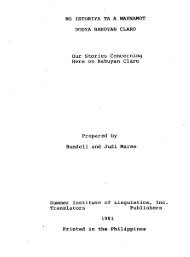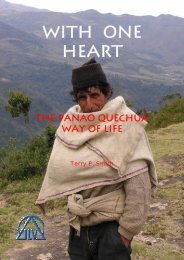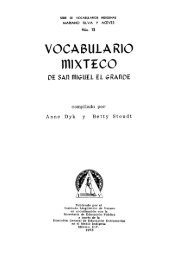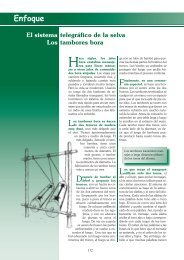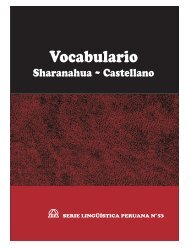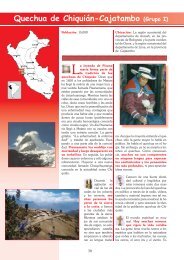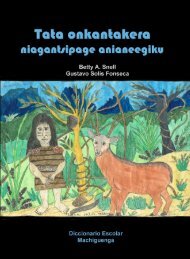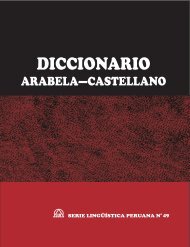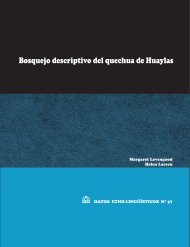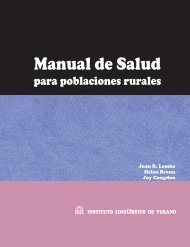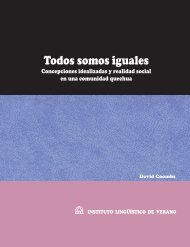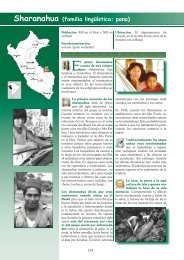Making Literature Alive: A Closer Look at Pala'isgen, a ... - Sil.org
Making Literature Alive: A Closer Look at Pala'isgen, a ... - Sil.org
Making Literature Alive: A Closer Look at Pala'isgen, a ... - Sil.org
- No tags were found...
You also want an ePaper? Increase the reach of your titles
YUMPU automatically turns print PDFs into web optimized ePapers that Google loves.
<strong>Making</strong> <strong>Liter<strong>at</strong>ure</strong> <strong>Alive</strong>: A <strong>Closer</strong> <strong>Look</strong> <strong>at</strong> Pala’isgen, aTagbanua EthnoepicJonalyn B. VillarosaPalawan St<strong>at</strong>e Universityjonahvi@lycos.comAbstractThe Tagbanua, one of the ethnic groups of Palawan, has rich cultural and literaryheritage which includes the ethnoepic Pala’isgen. Consisting of six chapters, the epic details theheroic exploits of Pala’isgen who is endowed with supern<strong>at</strong>ural powers which he uses indefending his people against their enemies.Pala’isgen is comparable with other Filipino ethnoepics; however, it still remains asunexplored wealth. This may be <strong>at</strong>tributed to the absence of its public<strong>at</strong>ion or inclusion in <strong>at</strong>extbook or anthology. This prompted the researcher to find a way by which Pala’isgen could beincluded in English classes, particularly in first year high school which focuses on Philippineliter<strong>at</strong>ure.Pala’isgen was recorded, transcribed, and transl<strong>at</strong>ed into Filipino by Dr. Paul Jagmis, Sr..His Filipino transl<strong>at</strong>ion was the basis of the researcher’s English transl<strong>at</strong>ion.The researcher also conducted an ethnographic research in Cabigaan, Aborlan, Palawan,where many of the Tagbanua live, including the man who chanted the longest portion of the epic.Thus, the researcher’s description of the residence of the Tagbanua, their sources of livelihood,culture and values enriched the teaching m<strong>at</strong>erials.The researcher then prepared four sample lesson plans emphasizing studentcenteredactivities. Afterward, the researcher developed an instructional compact disk (CD) to aid inteaching the Pala’isgen. The disk contains the English transl<strong>at</strong>ion, a summary, inform<strong>at</strong>ion aboutthe Tagbanua, sample lesson plans, and a glossary.The teaching m<strong>at</strong>erials were then field tested in three first year classes in Palawan St<strong>at</strong>eUniversity Labor<strong>at</strong>ory High School. Based on the evalu<strong>at</strong>ion of faculty observers, the studentsparticip<strong>at</strong>ed enthusiastically in the activities, liked the Pala’isgen, and confirmed th<strong>at</strong> the use of theCD and other instructional m<strong>at</strong>erials helped them understand the epic.The observers’ and students’ evalu<strong>at</strong>ion affirmed the researcher’s idea th<strong>at</strong> Pala’isgencould become an interesting literary piece and could enliven the teaching of liter<strong>at</strong>ure in ourschools.1. IntroductionThe Tagbanua, one of the various ethnic groups in Palawan, has rich cultural and literaryheritage. Several studies about the Tagbanua th<strong>at</strong> have been conducted for the past two decades<strong>at</strong>test to this st<strong>at</strong>ement. However, despite the number of studies conducted about it, manyFilipinos, including Palaweños, are not yet aware of the way of life of the Tagbanua. This lack ofawareness often leads to inappropri<strong>at</strong>e descriptions or judgments about them. Inasmuch asknowledge about the Tagbanua shall pave the way toward understanding them, there is a need tofind means to know them. This quest of knowing them could begin by studying their liter<strong>at</strong>ure.
2One of the various types of liter<strong>at</strong>ure is the epic. Baltazar (1981) st<strong>at</strong>ed th<strong>at</strong> “among theoutstanding pieces of our literary heritage are the folk epics which are narr<strong>at</strong>ives of sustainedlength, based on oral traditions revolving around supern<strong>at</strong>ural events or heroic deeds in the formof verse which is either chanted or sung with a certain seriousness or purpose. Epics embody orvalid<strong>at</strong>e the beliefs, ideals or lifevalues of the people.”The Filipino epics are more properly ethnoepics, belonging to and representing ethnic groupsand dealing with regional heroes (Nieto and Viray 1993) unlike the n<strong>at</strong>ional epics of othercountries such as Greek’s Illiad and Odyssey which represent Greece as a n<strong>at</strong>ion and exaltOdysseus and the other outstanding epic characters (like Agamemnon and Achilles) as n<strong>at</strong>ionalheroes.The Philippines abounds in ethnoepics. This st<strong>at</strong>ement is supported by the findings of theASEAN – sponsored study of Filipino epics th<strong>at</strong> “ there are one hundred (100) extant epics in thecountry th<strong>at</strong> have been discovered, most of these are from Palawan ” (Santiago 2002). However,many of these ethnoepics have not yet been documented.Having learned about the existence of other unrecorded epics in Palawan, the researcher (asan undergradu<strong>at</strong>e student) and her research group were motiv<strong>at</strong>ed to record an epic for theirthesis. With this objective in mind, they conducted a study entitled,“ Palaisgen: a TagbanuaEpic” in 1994. The researchers’ original objective was to record the whole epic, but it did notm<strong>at</strong>erialize because of time and financial constraints. Wh<strong>at</strong> they were able to record was achapter of Pala’isgen (Isgen Pala’isgen’s Fight with Tigri) which they transl<strong>at</strong>ed into Filipinoand English. They also analyzed the Tagbanua culture th<strong>at</strong> is exemplified in the said chapter ofthe epic which was sung by Fernando Lingsa, a resident of Barangay Cabigaan, Aborlan,Palawan.In 1997, Jagmis completed his study entitled “Pala’isgen: ang Epiko ng Tagbanua.” Jagmis’study consists of two parts. The first part is the ethnography of the Tagbanua which includestheir geography and demography, life and society, and m<strong>at</strong>erial and nonm<strong>at</strong>erial culture. Thesecond part is the epic entitled “Pala’isgen”.Consisting of six chapters, Pala’isgen tells of the heroism of Pala’isgen, a brave Tagbanuaendowed with supern<strong>at</strong>ural power which he uses in fighting the enemies to defend the Tagbanuarace. Considered as the loftiest and longest piece of Tagbanua liter<strong>at</strong>ure, Pala’isgen was sung byGemgem Bagued and Fernando Lingsa, n<strong>at</strong>ives of Aborlan, Palawan. One part of the epic wasnarr<strong>at</strong>ed by Delia Jardinero. The said epic was valid<strong>at</strong>ed by several Tagbanua elders in Aborlan.Pala’isgen is comparable with the other Filipino ethnoepics. However, unlike the otherethnoepics such as Biag ni lamang and Darangen th<strong>at</strong> are included in the study of Philippineliter<strong>at</strong>ure, Pala’isgen remains as unexplored wealth. One reason for this is the absence of <strong>at</strong>extbook or reading m<strong>at</strong>erial which includes Pala’isgen or any instructional m<strong>at</strong>erial th<strong>at</strong> containsthe said epic. This prompted the researcher to find a way by which Pala’isgen could be includedin Philippine liter<strong>at</strong>ure classes.
3Philippine liter<strong>at</strong>ure is a component of the secondary and tertiary curricula in the country. Inthe secondary school curriculum, it is a part of the English subject or program for first year highschool.The first year high school students are expected, among other things, to do the following: (1)discover Philippine liter<strong>at</strong>ure as a means of having understanding of man and his environment,(2) discover through liter<strong>at</strong>ure the need to work cooper<strong>at</strong>ively and responsibly in today’s globalvillage, and (3) show understanding and appreci<strong>at</strong>ion of various literary types with emphasis onPhilippine liter<strong>at</strong>ure (Dep Ed 2002). Taking these objectives into consider<strong>at</strong>ion, Pala’isgen couldbe an important instrument for knowing, understanding, and appreci<strong>at</strong>ing not just the epic butalso the Tagbanua people.Since Pala’isgen is clearly a part of Philippine liter<strong>at</strong>ure, the researcher believes th<strong>at</strong> it has tobe read, studied, and dissemin<strong>at</strong>ed. Inasmuch as the complete epic is in the Tagbanua andFilipino languages, the researcher saw the need to transl<strong>at</strong>e it first into English so th<strong>at</strong> it could beincluded in the study of Philippine liter<strong>at</strong>ure in the English subject of the first year high school.Moreover, the researcher considered it necessary to make lesson plans showing how Pala’isgencould be taught through appropri<strong>at</strong>e teaching str<strong>at</strong>egies or methods with emphasis on studentcenteredactivities. The teaching of the said epic can start by including it as part of the study ofPhilippine liter<strong>at</strong>ure in the English subject for first year high school <strong>at</strong> Palawan St<strong>at</strong>e University.Pala’isgen can be taught as an additional literary piece or as a replacement for epics from otherprovinces in the country. Including Pala’isgen in the curriculum will help in making the studentsaware of the rich literary and cultural heritage of the Tagbanua. It will also help them in knowingand understanding the Tagbanua people.Furthermore, since Palawan St<strong>at</strong>e University envisions global competitiveness, computertechnology must be used in instruction. This is due to the fact th<strong>at</strong> computer technology is nowconsidered as an important tool in educ<strong>at</strong>ion in today’s fastpaced world. Since liter<strong>at</strong>ure is a partof educ<strong>at</strong>ion, its teaching can be enhanced by computer technology (Porter 1999).In line with this, the researcher deemed it necessary to develop instructional m<strong>at</strong>erial in theform of a compact disk (CD) which will be significant in teaching and in perpetu<strong>at</strong>ingPala’isgen. The CD will also be a response to the demands of the changing times for the teachersto be “involved in the production of instructional m<strong>at</strong>erials” (AACCUP).With these premises, the researcher embarked in this study with the hope th<strong>at</strong> Pala’isgen, theTagbanua epic, be considered an additional gem in Philippine liter<strong>at</strong>ure.2. Methodology2.1 Research DesignThis study is a qualit<strong>at</strong>ive research. Particularly, this study used descriptive and ethnographicmethods. The descriptive method was used in transl<strong>at</strong>ing Pala’isgen into English while theethnographic or fieldwork method was used in g<strong>at</strong>hering inform<strong>at</strong>ion about the Tagbanua. Thespecific ethnographic or fieldwork techniques th<strong>at</strong> were employed were observ<strong>at</strong>ion andunstructured interview. The research procedure includes the transl<strong>at</strong>ion of Pala’isgen, fieldwork,
4prepar<strong>at</strong>ion of lesson plans, development of the computerassisted instructional m<strong>at</strong>erial (CD)and field testing.2.1.1 Transl<strong>at</strong>ion of Pala’isgen(a) Seeking Permission from Dr. Paul D. Jagmis, Sr.Before the researcher began the transl<strong>at</strong>ion of the Filipino version of Pala’isgen into English,she sought first the permission of Dr. Paul Jagmis, Sr. because it was he who recorded,transcribed, and transl<strong>at</strong>ed the said ethnoepic. It was included in his dissert<strong>at</strong>ion entitled“Pala’isgen: Ang Epiko ng Tagbanua” in 1997.Dr. Paul D. Jagmis, Sr. is a Tagbanua who has lived in Cabigaan, Aborlan, Palawan. Amongthe Tagbanua of Aborlan, Dr. Jagmis is a highlyesteemed tribal leader. Aside from hisdissert<strong>at</strong>ion on Pala’isgen, he has also written and presented articles about the Tagbanua culturein local and n<strong>at</strong>ional levels.(b) Writing of the First DraftThe researcher read first the whole Filipino text of Pala’isgen. Then, she proceeded with thetransl<strong>at</strong>ion of the epic into English by line.(c) Evalu<strong>at</strong>ion of the Transl<strong>at</strong>ionEach line of the English transl<strong>at</strong>ion was placed opposite the Filipino text. This was done soth<strong>at</strong> the evalu<strong>at</strong>ors could easily look into the transl<strong>at</strong>ion.Example:At ang sabi moSi Letang B<strong>at</strong>oNandoon na kumapit naDoon kay Pala’isgenAnd you saidLetang B<strong>at</strong>oHeld onTo Pala’isgen.After making the revised draft for evalu<strong>at</strong>ion, the researcher gave a copy to each of theevalu<strong>at</strong>ors. Then, the researcher invited the evalu<strong>at</strong>ors for the evalu<strong>at</strong>ion of the transl<strong>at</strong>ion. Oneof the evalu<strong>at</strong>ors was Dr. Paul Jagmis, Sr.Comparison check was used in evalu<strong>at</strong>ing the epic. During the evalu<strong>at</strong>ion, the researcherread each line of the epic in Filipino and English to the evalu<strong>at</strong>ors. The evalu<strong>at</strong>ors looked intothe correctness, appropri<strong>at</strong>eness, clarity, and n<strong>at</strong>uralness of expression of the transl<strong>at</strong>ion.Emphasis was given on lines or stanzas th<strong>at</strong> the committee found necessary to revise orimprove. After the evalu<strong>at</strong>ion of the transl<strong>at</strong>ion, the researcher made the necessary revisions.
62.1.3 Lesson PlanningAfter the fieldwork, the researcher prepared four semidetailed lesson plans based on the2002 Basic Educ<strong>at</strong>ion Curriculum (BEC).The first lesson plan is designed for the whole epic to be taught over a period of three hours.The second lesson plan, to be taught over two hours, also covers the whole epic.The third lesson plan focuses on Chapter V (Pala’isgen’s Fight with the Giants ) with thetime allotment of sixty minutes. Lastly, the fourth lesson plan which focuses on Chapter VI(Pala’isgen and His Brothers’ Fight with Tigre) is designed to be taught over two hours.The lesson plans were evalu<strong>at</strong>ed by a committee which included four professors who teachlanguage and liter<strong>at</strong>ure and professional educ<strong>at</strong>ion subjects in Palawan St<strong>at</strong>e University. All ofthe members of the committee, except the English teacher from the Labor<strong>at</strong>ory High School, aregradu<strong>at</strong>e degree holders. Their length of teaching experience ranges from eleven (11) to twentynine (29) years.2.1.4 Development of the CDWith these things ready—transl<strong>at</strong>ion, inform<strong>at</strong>ion about the Tagbanua, and sample lessonplans—the researcher moved on to the next phase, the development of the instructional compactdisk (CD).The CD was then presented for evalu<strong>at</strong>ion. The committee on evalu<strong>at</strong>ion was composed oftwo faculty members who underwent training on Intel teach to the Future Program and anEnglish teacher with specializ<strong>at</strong>ion in Instructional Development and Technology. Their lengthof teaching experience ranges from nine (9) to fifteen (15) years.2.1.5 Field TestingTo test the implement<strong>at</strong>ion of the lesson plans and the use of the newlydeveloped CD, theresearcher conducted field testing in the Labor<strong>at</strong>ory High School <strong>at</strong> Palawan St<strong>at</strong>e University.The field testing was done in IKabaitan, IPagasa, and I Kagitingan. I Kabaitan wascomposed of fifty two (52) students (18 boys and 34 girls) while I –Pagasa consisted of fiftyfour(54) students (24 boys and 30 girls). In I – Kagitingan, there were fifty two (52) students(23 boys and 29 girls).From the four sample lesson plans prepared by the researcher, only three were used for thetryouts. Lesson Plan Number 1 was used for IKabaitan, Lesson Plan Number 3 for IKagitingan, and Lesson Plan Number 4 for IPagasa. The researcher implemented lesson PlanNumber 1 while the English teacher of the said classes used Lesson Plan Number 4. A Bachelorof Secondary Educ<strong>at</strong>ion (BSEd) student teacher tried out Lesson Plan Number 3.Each tryout was observed by two professors from the College of Educ<strong>at</strong>ion. For the threetryouts, the total number of observers is five (5) because one of them observed two classes.
7From the five observers, two were members of the committee who had evalu<strong>at</strong>ed the lesson planswhile the other two had evalu<strong>at</strong>ed the CD. The other observer had verified the Inform<strong>at</strong>ion aboutthe Tagbanua. The observers, except the one from the Labor<strong>at</strong>ory High School, are gradu<strong>at</strong>edegree holders. Their length of teaching experience ranges from eleven (11) to thirtyseven (37)years.To guide the observers in evalu<strong>at</strong>ing the implement<strong>at</strong>ion of the lesson plans and the use ofthe CD, the researcher prepared an observ<strong>at</strong>ion form which consisted of six (6) questions in linewith students’ interest and particip<strong>at</strong>ion in the activities, time allotment and instructionalm<strong>at</strong>erials used. Three sets of observ<strong>at</strong>ion forms were used for the three classes.The observers in IKabaitan remarked th<strong>at</strong> the implement<strong>at</strong>ion was excellent. Based on theobservers’ evalu<strong>at</strong>ion, the students particip<strong>at</strong>ed in the activities with interest, they werechallenged by the activities, there was adequ<strong>at</strong>e time for the activities, and the m<strong>at</strong>erials usedwere appropri<strong>at</strong>e and helpful in making the tasks and the expect<strong>at</strong>ions clear.Likewise, the implement<strong>at</strong>ion of the lesson plan number 4 in IPagasa was r<strong>at</strong>ed asimpressive by the observers. The following remarks came from one of the evalu<strong>at</strong>ors:“The present<strong>at</strong>ion was well<strong>org</strong>anized and system<strong>at</strong>ic with the use of visual aids/m<strong>at</strong>erialsequipped with wh<strong>at</strong> the teacher wanted to evalu<strong>at</strong>e <strong>at</strong> the end of the discussion. Time allotted foreach activity for the students was just enough for them to present their output. The lesson callsfor cre<strong>at</strong>ive and critical thinking on the part of the students. Each of them showed interest,appreci<strong>at</strong>ion and enjoyment in wh<strong>at</strong> they were doing. As a result, it was really gre<strong>at</strong>!”For IKagitingan , the observers noted th<strong>at</strong> the objectives of the lesson were carried out.The students in the said classes were also asked to give their evalu<strong>at</strong>ion of the tryouts. Allthe students in three classes expressed th<strong>at</strong> they liked Pala’isgen and they confirmed th<strong>at</strong> the useof the CD and other instructional m<strong>at</strong>erials helped them in understanding the epic.When asked about their suggestions to improve the lesson on Pala’isgen, most of the studentsremarked th<strong>at</strong> they had no suggestions as one of them wrote:“ The lesson was taught in a manner th<strong>at</strong> is easy to understand; so, I do not have anyadditional suggestions.”One of them added: “ It is clear and the story is beautiful. Even the drawings are pretty.”Another comment th<strong>at</strong> manifested student’s interest toward the lesson was: “ I want to knowthe whole story. I want it to be a part of our lesson the whole high school.”
83. Present<strong>at</strong>ion of the Transl<strong>at</strong>ion and Learning Resource M<strong>at</strong>erialThe following are selected parts of the transl<strong>at</strong>ion and the contents of the CD.3.1 Transl<strong>at</strong>ionI. Pagdalaw ni Palaisgen Palaisgen’s Visit<strong>at</strong>ion to thesa mga Tao sa MundoPeople on EarthAng wika ni Pala’isgen“Bunso kong kap<strong>at</strong>idNa LiokyanganBilisan mo na.Ihanda mo ang aking bangka.Mayroon tayong hahanapin”Ano pa ang masabi moSa kilos ni LiokyanganNandoon na nakahanda naAng bangka niya na sasakyanAng bangka niyang ginintuanNakita niya, n<strong>at</strong>anaw niyaHabang siya’y nasa himpapawidNa may dalawa, may t<strong>at</strong>lo naMarami ng tao ang pinap<strong>at</strong>ay.Naroon na sumakay naNandoon na lumakbay naMula sa langit sila.Itong si MagrengTumira sa tabing dag<strong>at</strong>Dalampasigan sa tabing dag<strong>at</strong>T<strong>at</strong>lo ap<strong>at</strong> ang anak niyaIsa na si Pala’isgenPanganay si BuayaSumunod si BaybayanenIk<strong>at</strong>lo si PalaisgenIkaap<strong>at</strong> si Liokyangan.Itong si Pala’isgenM<strong>at</strong>agal na sa daigdigN<strong>at</strong>anaw na niyang lah<strong>at</strong>Na mga kaguluhanWika niya sa mundo“Tigilan ninyong lah<strong>at</strong>Pala’isgen said,“My youngest brotherLiokyanganHurry up.Prepare my bo<strong>at</strong>.There’s something we shall lookfor.”Wh<strong>at</strong> can you sayAbout Liokyangan’s action?There he preparedThe bo<strong>at</strong> he will ride onHis golden bo<strong>at</strong>.He sawWhile he was in the skyThere were two, then threeMany people were being slain.They rodeThey traveledFrom the clouds.MagrengLived near the seaBy the seashore.Four were his childrenOne was Pala’isgenBuaya was the eldestBaybayanen followedPala’isgen was the thirdLiokyangan was the fourth.Pala’isgenStayed long on earth.He saw allThe troubles.To the world he said,“ All of you, stop
9Malilipol ang tao n<strong>at</strong>in.”Yan.Lah<strong>at</strong> ng tao’y huminto naHuminto sa pakikidigmaSumunod ito sa kaniyaAng lah<strong>at</strong> ay mapayapa na.Yan.Our people will perish.” Th<strong>at</strong>’s it.All the people stoppedStopped fightingThey followed himAnd all was <strong>at</strong> peace.Th<strong>at</strong>’s it.3.2 Learning Resource M<strong>at</strong>erial on CDThe CD contains the following: welcome page, transl<strong>at</strong>ion, summary, inform<strong>at</strong>ion aboutthe Tagbanua, sample lesson plans, and glossary of terms.3.2.1 Welcome PageThe welcome page orients the teachers about the contents of the CDROM. This pagealso includes some instructions in line with the implement<strong>at</strong>ion of the sample lesson plans inteaching Pala’isgen for first year high school.The welcome page is followed by an introduction on Pala’isgen which a briefbackground about Dr. Paul D. Jagmis, Sr. and the Tagbanua elders who chanted Pala’isgen. Thesucceeding part contains the list of characters. The descriptions of the characters are based on theresearcher’s interview with Fernando Lingsa, the Tagbanua who chanted the sixth part ofPala’isgen.3.2.2 Transl<strong>at</strong>ionThe transl<strong>at</strong>ion is divided into six (6 ) parts. These are the following: 1) Pala’isgen’sVisit<strong>at</strong>ion to the People on Earth, 2) Pala’isgen’s Courtship of Tubod k<strong>at</strong> Bulawan, 3) TheWedding Feast of Pala’isgen and Tubod K<strong>at</strong> Bulawan, 4) The Visit<strong>at</strong>ion of Letang B<strong>at</strong>o toPala’isgen and Tubod k<strong>at</strong> Bulawan, 5)Pala’isgen’s Fight with the Giants, and 6) Pala’isgen’s andHis Brothers’ Fight with Tigre. The summary of the epic comes after the transl<strong>at</strong>ion.3.2.3 Inform<strong>at</strong>ion about the TagbanuaThe inform<strong>at</strong>ion about the Tagbanua includes their residence, source of livelihood,culture and values. Some Tagbanua values are presented below.(a) Strong Family TiesThe Tagbanua value their families. This is not only limited to their immedi<strong>at</strong>e family butit extends up to their rel<strong>at</strong>ives or their clan.As one of the manifest<strong>at</strong>ions of this bind th<strong>at</strong> connects the Tagbanua together, marriedchildren build their houses near their parents’ house. Since the Tagbanua follow m<strong>at</strong>rilocalresidence rule, couples live close to the woman’s family. They form a cluster of houses whichmarks an extended family or clan. This they do for them to assist their family easily whenever
10they are needed. At present, however, married children may also choose to live in anotherplace.The Tagbanua are always ready to help whoever in the family needs assistance. Forexample, if a member of a family gets sick, his/her rel<strong>at</strong>ives readily assist him/her bycontributing money th<strong>at</strong> he/ she needs to buy medicine or for hospitaliz<strong>at</strong>ion.(b) RespectThe Tagbanua respect their parents and elders. They address their grandparents as Apo;their f<strong>at</strong>hers as Ama; their mothers as Ina; their aunts as Menan; their uncles as Amay; and theirbrothers or sisters as Aka.The children obey their parents. They follow wh<strong>at</strong> their parents tell them to do. If theirparents get old, they take care of them. They believe th<strong>at</strong> they have to take good care of theirparents to repay them for taking care of them when they were still young.In an extended family or clan (sansulsugan), the eldest is usually considered as the head.He is respected by his clan and his advice is always sought.( c) BayanihanThe Tagbanua practise the bayanihan system. For example, during planting season, if afarmer needs help, his fellows come to help him in planting. He does not pay them; he onlyserves them food. In return, he also helps when his fellow farmer’s turn to plant comes.( d ) Debt of Gr<strong>at</strong>itudeThe Tagbanua value or cherish wh<strong>at</strong>ever help is extended to them. They consider it asutang nga nakem (debt of gr<strong>at</strong>itude). Throughout their lives, their gr<strong>at</strong>efulness to the person whohas helped them in time of need remains. In return, they are always ready to help the person whohas helped them even if they will not be asked to do so.( e) PakikisamaFor the Tagbanua, this value is like giving consider<strong>at</strong>ion for others to maintain aharmonious rel<strong>at</strong>ionship among them. For example, when a Tagbanua is invited to a g<strong>at</strong>hering,he/she has to <strong>at</strong>tend. If he/she cannot <strong>at</strong>tend, he/she has to explain his/ her reasons to the one whoinvited.3.2.4 Lesson PlansThe following are the descriptions of the sample lesson plans th<strong>at</strong> are included in the CD.
11Lesson Plan Number 1Designed to be taught over three days, this lesson plan is for the whole epic (from Part Ito Part VI). In this lesson, the students identify, describe, and evalu<strong>at</strong>e characters with the aid ofstudent activity sheets like major character traits and clues about a character. Students will alsoillustr<strong>at</strong>e the setting and dram<strong>at</strong>ize scenes from the epic. They are also expected to point out theTagbanua culture and values th<strong>at</strong> are shown in the epic. Lastly, they reflect and write about theirown traits.Lesson Plan Number 2This lesson plan is designed to be taught over two days. Students will describe thecharacters, illustr<strong>at</strong>e the setting, and trace the plot of the epic. They will also point out thecharacteristics of Pala’isgen, the epic hero. Moreover, they will identify the culture of theTagbanua as shown in the epic. Lastly, students will show how they can be heroes, too.Lesson Plan Number 3Designed for a sixtyminute period, this lesson plan focuses on Part V of Pala’isgen.Students will identify and evalu<strong>at</strong>e the characters. They will also identify the main character’sproblem and his solution to it. Furthermore, students link the said part of the epic to rel<strong>at</strong>edcurrent issues in the Philippines.Lesson Plan Number 4With Part VI as its focus, this lesson plan is designed to be taught over two days. Asidefrom identifying and evalu<strong>at</strong>ing the characters, students will also trace and discuss the plotthrough a flow chart. Moreover, they will point out the Tagbanua culture and values th<strong>at</strong> arereflected in Part VI. In addition, students rel<strong>at</strong>e a value from the epic with their own lives. Theywill also analyze symbols and link these with our society <strong>at</strong> present.3.2.5 GlossaryThe CD also contains the glossary of terms used in Pala’isgen and in the Inform<strong>at</strong>ion aboutthe Tagbanua. Some of these terms are agong, antenganen, babylan, kilala, langguway, andmasicampo.4. Conclusion and Recommend<strong>at</strong>ionBased on the observers’ and students’ evalu<strong>at</strong>ion, Pala’isgen could become an interestingliterary piece and the teaching of liter<strong>at</strong>ure could be made alive through the use of studentcenteredactivities. Hence, it is recommended th<strong>at</strong> Pala’isgen be included in the study ofPhilippine liter<strong>at</strong>ure in first year high school.
12ReferencesA. BooksBaltazar, <strong>Sil</strong>verio et al. 1981.Philippine <strong>Liter<strong>at</strong>ure</strong>: Past and Present. Quezon City: K<strong>at</strong>haPublishing Co.,Inc.Bayuga, Rosy May M. A 1989.Tagbanua Legacy: History of Palawan N<strong>at</strong>ional AgriculturalCollege. Aborlan, Palawan: Palawan N<strong>at</strong>ional Agricultural College.Delima, Purificacion G. 1996. Technology in Language Educ<strong>at</strong>ion. Diliman, Quezon City:University of the Philippines Open University.Department of Educ<strong>at</strong>ion. 2002. Oper<strong>at</strong>ions Handbook in English, Basic Educ<strong>at</strong>ionCuriculum, Secondary Level. Pasig City: Department of Educ<strong>at</strong>ion.Diaz De Rivera, Lina D.1997. <strong>Liter<strong>at</strong>ure</strong>Based Reading Programs. Diliman, Quezon City:University of the Philippines Open University.Dy, Dolly. “Preserving Palawan”, Bountiful Palawan. 1991.Philippines: Aurora Public<strong>at</strong>ions,Inc.Fernandez, Jose and Fe Fernandez. 1991.Mga Karantaen sa Palawan.Fox, Robert. “Tagbanua”, Bountiful Palawan. 1991.Philippines: Aurora Public<strong>at</strong>ions, Inc.Garcia, Carolina U. and Ophelia A. Dimalanta.1994.Highlights of World <strong>Liter<strong>at</strong>ure</strong>. Manila:University of Santo Tomas.Griffith, Kelly Jr. 1986.Writing Essays About <strong>Liter<strong>at</strong>ure</strong>: A Guide and Style Sheet. UnitedSt<strong>at</strong>es of America: Harcourt Brace Jovanovich.Kral, Thomas. The Lighter Side of Teaching English as a Foreign Language.Lazear, David G.1992. Teaching for Multiple Intelligences. Indiana: Phi Delta KappaEduc<strong>at</strong>ional Found<strong>at</strong>ion.Mac Donald, Nicole R. and Edgar B. Maranan. 1991.Kudaman: Isang Epikong Palawan naInawit ni Usuy.Manila: Ateneo de Manila University Press.Miller, Gale and Robert Dingwall , editors. 1997. Context and Method in Qualit<strong>at</strong>ive Research.London: SAGE Public<strong>at</strong>ions, Inc.Tolentino, Delfin Jr. L. 1997. Literary Theory and Critical Practice. Diliman, Quezon City:University of the Philippines Open University.Yabes, Criselda. 1999.Letters from Palawan. Mak<strong>at</strong>i City: Bookmark, Inc.
13B. JournalsCampbell, Linda. 1997. How Teachers Interpret MI Theory. Educ<strong>at</strong>ional Leadership. 55 (1).Checkley, K<strong>at</strong>hy. 1997. The First Seven… and the Eighth: A Convers<strong>at</strong>ion with HowardGardner. Educ<strong>at</strong>ional Leadership. 55 (1).Galavis, Benicio. 1998. Computers and the EFL Classes: Their Advantages and a PossibleOutcome, the Autonomous Learner. English Teaching Forum. 36 (4).Hemei, Jiang. 1997. Teaching with Video in Class. English Teaching Forum. 35 (2).Mirescu, Simona. 1997. ComputerAssisted Instruction in Language Teaching. EnglishTeaching Forum. 35 (1).Tillyer, Anthea. 1997.The infiNET Possibilities. English Teaching Forum. 25 (1).C. Unpublished M<strong>at</strong>erialsBondoc, Andrea R. 1996. Isang Salin sa Filipino ng mga Kaban<strong>at</strong>a 5 <strong>at</strong> 6 “The C<strong>at</strong>holic FaithC<strong>at</strong>echism” ng Episcopal Commission on C<strong>at</strong>echesis and C<strong>at</strong>holic Educ<strong>at</strong>ion. M.A.Thesis. Philippine Normal University.Jagmis, Paul Sr. D. 1997. Pala’isgen: Ang Epiko ng Tagbanua. Ph.D. Dissert<strong>at</strong>ion. Holy TrinityCollege.Nieto, Minerva and Eunice T. Viray. 1993. A Compar<strong>at</strong>ive Analysis of Two FilipinoEthnoepics: The Ilocano Biag ni Lamang and the Narr<strong>at</strong>ive Account of Bantogen in theMaranao Darangen. M.A. Thesis. Palawan St<strong>at</strong>e College.Socr<strong>at</strong>es, Nita J. 1993.Indigenous Helping Practices Among the Tagbanua: A Found<strong>at</strong>ion fora Multicultural Perspective in Counseling. Ed. D. Dissert<strong>at</strong>ion, University of thePhilippines.Villarosa , Jonalyn B. et al. 1994. Pala’isgen: a Tagbanua Epic. Undergradu<strong>at</strong>e Thesis. PalawanSt<strong>at</strong>e College.D. Online ResourcesMacasantos, Francis and Priscila S. Macasantos. Philippine <strong>Liter<strong>at</strong>ure</strong> in the Spanish ColonialPeriod. .6 Aug. 2003.Ortega, Christine G. Literary Forms in Philippine <strong>Liter<strong>at</strong>ure</strong>.. 6 Aug. 2003
The preceding document was presented <strong>at</strong> the Tenth Intern<strong>at</strong>ionalConference on Austronesian Linguistics (10ICAL). To properly referencethis work, please use the following form<strong>at</strong>:, . 2006. . Paper presented <strong>at</strong> TenthIntern<strong>at</strong>ional Conference on Austronesian Linguistics. 1720January 2006. Puerto Princesa City, Palawan, Philippines.http://www.sil.<strong>org</strong>/asia/philippines/ical/papers.htmlFor other papers th<strong>at</strong> were presented <strong>at</strong> 10ICAL, please visithttp://www.sil.<strong>org</strong>/asia/philippines/ical/papers.html.



